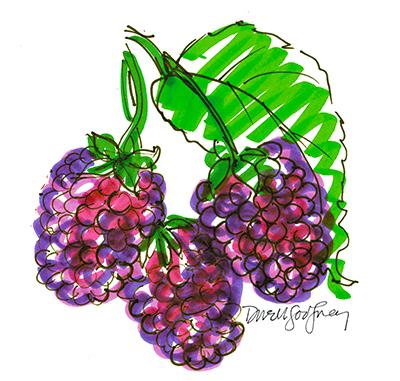Culinary Treats of Late Summer

Blackberries are one of the great culinary joys of late summer. They ripen at a time when most other berries are finishing, and though they tend to be a little sour when eaten fresh, they have fantastic flavor as well as a rich dark purple color when cooked. They are also great in that they are relatively easy to pick, since the berries are large and sturdy, with a central core that makes them far less fragile than raspberries.
For most of the year blackberries are expensive to buy in shops, but during August they are essentially free for the taking, growing wild in empty lots and in hedgerows, if only you know where to look.
For many years I didn’t bother to grow blackberries in my garden. I simply walked down the street to an empty lot where wild blackberries grew everywhere and picked as many as I liked. Or else I would stop my car on the way home from the beach to pick some by the side of the road. Once home, I would use them for jams, cobblers, and pies, or else just have them plain with some sugar and cream.
While many people still pick wild blackberries here, the places where they grow are fast disappearing. Most of my favorite wild blackberry spots in Bridgehampton have vanished in the past decade, replaced by grand new homes. So when a good friend pricked her thumb on a blackberry thorn a few years ago and got a serious infection, and then spent several weeks on antibiotics, I began to reconsider my forays into the wild, particularly since, apart from being more difficult to find these days, blackberries leave us foragers open not only to scratches from thorns, but also to chiggers, ticks, poison ivy, and (worst of all) tick-borne diseases.
Shortly afterward I sent away for some plants. Today, with very little effort, I have a highly productive trellis of thornless blackberries in my garden, one that begins fruiting at the end of July and continues until late August, with plenty of spare berries to share with appreciative birds.
Here’s the good news about growing blackberries: They are very, very easy. So long as they have sun, good soil, and sufficient water, they seem to grow just about anywhere on the East End, and within a year or two, if given all they need, they will multiply, with each new cane producing prodigious amounts of fruit.
Better yet, many (though not all) of the commercially available cultivars are thornless. Cultivated blackberries now come in two kinds — floricane, which fruits in midsummer, and primocane, in autumn, meaning that if you buy some of each, you can extend your blackberry season well into the fall. (But I have to admit that I have only summer-bearing blackberries on my trellis — a very dependable thornless variety called Chester — because blackberries seem so much a part of summer to me I am much less motivated to want them during the autumn.)
Lynch’s Garden Center in Southampton can special order thornless blackberries for those in search of them; they can also be purchased easily and inexpensively by mail, for example from Nourse Farms in Whately, Mass., which offers a broad selection of both floricane and primocane varieties: www.noursefarms.com/category/blackberry-plants/.
There is also some bad news about growing blackberries in your garden. First off, they are not very pretty. While they can easily be trellised or formed into an ornamental hedge, they are essentially top-heavy, scraggly-looking canes that grow tall (usually more than six feet) and then flop over unless given proper support. Second, they will soon spread (via their strong root systems) in all possible directions.
So, unlike a blueberry bush (or a gooseberry or red currant bush), they are going to need to be kept firmly in line. My answer to this problem has been to move my blackberries (and my raspberries, which have a similar but less vigorous growth habit) to a relatively hidden area of my garden where their natural untidiness and tendency to sprawl about is simply not a problem.
To keep your blackberry plants orderly, healthy, and highly productive, plant them in rows approximately three feet apart, and set up post-and-wire trellises for them, using a six-foot T-post at each end of the row and securing the canes using two or three levels of 14-gauge wire. (Or simply buy a trellis kit, which comes with crossbars for the wire, for example the trellis offered by agfabric.com: www.agfabric.com/product_show.asp?pid=28.)
You will also need to control their weedy growth at the soil level, which is most simply done by pulling up any canes that sprout up too far from the trellis, and then either replanting them elsewhere, giving them to friends (I recently gave some to that old friend of mine with the infected thumb), or else composting them. If you really want to limit the spread of the plants, consider sinking a root barrier (also known as a rhizome barrier) into the earth about a foot from the planting on either side of the row.
If you are lucky enough to have access to large quantities of blackberries, they make an excellent jam. Rich in antioxidants and low in calories, they are also full of health benefits (and many people put them into smoothies for this reason alone).
They also combine beautifully with stone fruits, either in a compote, a crumble, or a pie. But if you want to make an easy and impressive dessert, try this simple all-blackberry crumble. It is small enough to be made in a toaster oven, which is a nice way of keeping your kitchen cool during the hottest days of summer.
Click for recipe
Justin Spring is a writer whose most recent book, “Secret Historian,” was a finalist for the National Book Award. He divides his time between Bridgehampton and New York.
